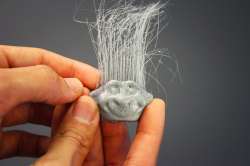New system to 3D print hair-like structures developed
Boston: Need hair? Just press print, say MIT scientists who developed a new way to 3D print thousands of hair-like structures within minutes on various surfaces, which can perform useful tasks such as sensing and

Boston: Need hair? Just press print, say MIT scientists who developed a new way to 3D print thousands of hair-like structures within minutes on various surfaces, which can perform useful tasks such as sensing and adhesion.
Instead of using conventional computer-aided design (CAD) software to draw thousands of individual hairs on a computer - a step that would take hours to compute - the team built a new software platform, called "Cilllia," that lets users define the angle, thickness, density, and height of thousands of hairs, in just a few minutes.
Using the new software, the researchers designed arrays of hair-like structures with a resolution of 50 microns – about the width of a human hair.
Playing with various dimensions, they designed and then printed arrays ranging from coarse bristles to fine fur, onto flat and also curved surfaces, using a conventional 3D printer.
The technology could possibly be used to print wigs and hair extensions, the researchers said. But their end goal is seeing how 3D-printed hair could perform useful tasks such as sensing, adhesion, and actuation.
To demonstrate adhesion, the team printed arrays that act as Velcro-like bristle pads. Depending on the angle of the bristles, the pads can stick to together with varying forces.
For sensing, the researchers printed a small furry rabbit figure, equipped with LED lights that light up when a person strokes the rabbit in certain directions. To see whether 3D-printed hair can help or move objects, the team fabricated a weight-sorting table made from panels of printed hair with specified angles and heights.
As a small vibration source shook the panels, the hairs were able to move coins across the table, sorting them based on the coins' weight and the vibration frequency.
Jifei Ou, a graduate student at Massachusetts Institute of Technology (MIT) in the US said that the work is inspired by hair-like structures in nature, which provide benefits such as warmth, in the case of human hair, and movement, in the case of cilia, which help remove dust from the lungs.
"We're just trying to think how can we fully utilise the potential of 3-D printing, and create new functional materials whose properties are easily tunable and controllable," Ou said.
To 3D-print hair using existing software, designers would have to model hair in CAD, drawing out each individual strand, then feed the drawing through a programme that represents each hair's contour as a mesh of tiny triangles.
The programme would then create horizontal cross sections of the triangle mesh, and translate each cross section into pixels, or a bitmap, that a printer could then print out, layer by layer.
Ou said designing a stamp-sized array of 6,000 hairs using this process would take several hours to process. To design hair, the researchers built a new software platform to model first a single hair and then an array of hairs, and finally to print arrays on both flat and curved surfaces.